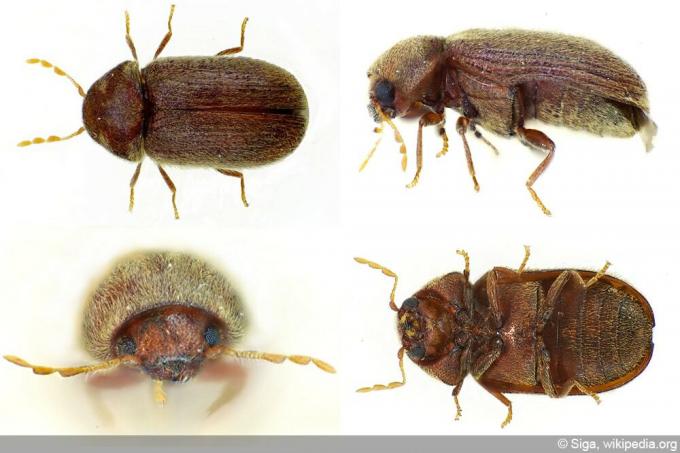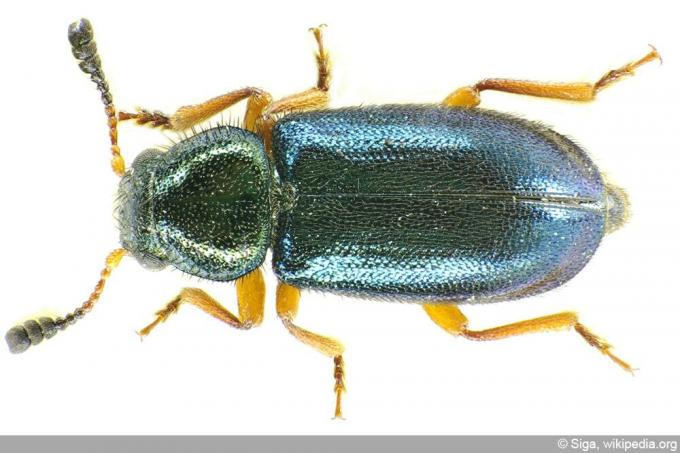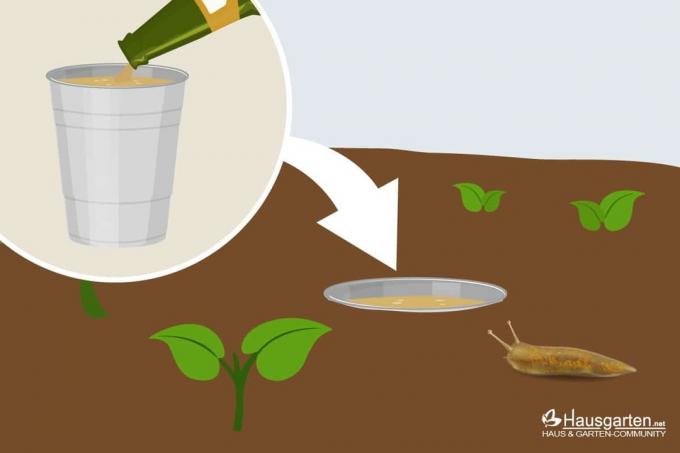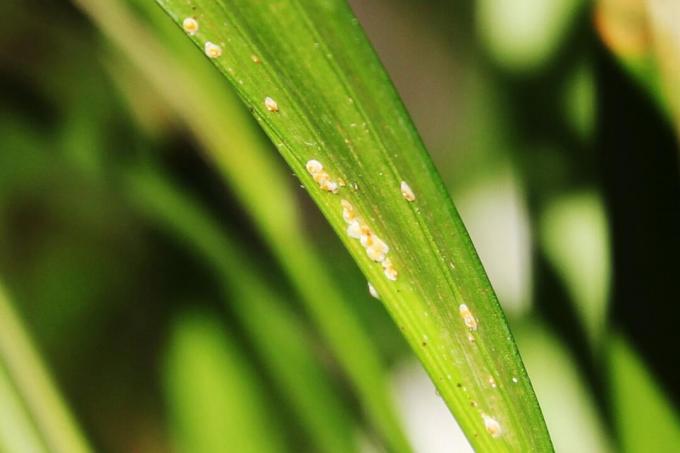

Table of contents
- First signs of infestation
- Endangered Food
- storage pests
- American flour beetle (Tribolium confusum)
- Australian thief beetle (Ptinus tectus)
- bread beetle (Stegobium paniceum)
- Pea seed weevil (Callosobruchus maculatus)
- Groundnut beetle (Oryzaephilus Mercator)
- Common bacon beetle (Dermestes lardarius)
- Grain flat beetle (Oryzaephilus surinamensis)
- Cheese mite (Tyrolichus casei)
- Flour mites (Acarus siro)
- Red-legged Ham Beetle (Necrobia rufipes)
Once storage pests have settled in, infested food is usually quickly spoiled/contaminated and a case for the bin. Such food damage can quickly become expensive if you don't react properly. In order to carry out effective control, it is essential to identify the storage pests. This guide gives you an overview of the most common critters and how to fight them effectively.
First signs of infestation
There are thousands of different insects out there, but not all are interested in your food supplies. You can tell when you have food pests in the house by the following characteristics:
- Live or dead insects near food
- Eaten food, packaging or the like
- Traces of insects such as larval skins, spider threads and sticky webs on food
- Clumped grain or pink flour
- Small black "dots" in loose foods like rice or sugar (usually feces)
Endangered Food
Storage pests are not interested in all foods. They are mainly found in dry products, regardless of whether they are of plant or animal origin. The following is an overview of the preferred food sources for food pests:
- Bakery products
- Meat
- grain products
- Cheese
- sweets
- tobacco
- pet food
- dried fish
- dried fruit
storage pests
Here are a few storage pests, how to recognize them, where they occur, what health risks they pose and how you can combat them.
American flour beetle (Tribolium confusum)

Recognize
- Body length of three to four millimeters
- Reddish brown color
- Wide set eyes visible only from the lower side of the body
- Extended antennae with a thickening running upwards
- Can fly, but usually doesn't
- Larvae are white to yellow-brown
- Larval body length: one to five millimeters
- They have three pairs of legs
- Leave dark feces in food
- Meat meal can be found on harder foods
- Food can change its smell and taste
Happen
These food pests feed on grain products and primarily infest flour. He is mainly drawn to bakeries or in cupboards and drawers at home, where baked goods and baking ingredients are kept.
health hazard
The American flour beetle produces the so-called "quinone". According to the latest research results, this is one of the carcinogenic substances. For this reason, these food pests should be combated immediately and infested food should be disposed of.
combat
This storage pest calls for direct control, which you can achieve with a non-toxic contra-insecticide. These are usually based on silica or contain fossil plankton. This affects the wax layer on the body surfaces, causing them to dry out and as a result the flour beetle dies.
Products with the active ingredients tea tree oil or neem oil work on a biological basis. The purely herbal pyrethrum extract is also an effective neurotoxin. This is obtained from chrysanthemums and is harmless to humans and pets.
Australian thief beetle (Ptinus tectus)
Recognize
The Australian thief beetle has some distinctive features that usually make identification fairly easy:
- Body length: 2.5 millimeters to a maximum of four millimeters
- Matte, dark brown base color
- Golden brown to grey-white hairs that lie close to the body
- Upright and lined up bristles on the elytra
- Small white dots in the feeding substrate (eggs laid)
- "Cobwebs" on food and packaging
- Small "drill holes" in leather, plastic, paper or cardboard packaging
- Females are nocturnal
- They cannot fly and fear the light
- When danger threatens, they play dead
Happen
The Australian thief beetle is mainly at home in the nests of pigeons and sparrows. But the smell of various foods also draws you into the kitchen and pantry, where it doesn't stop at packaging, such as:
- tea
- Spices
- dried fruit
- malt
- Yeast
- semolina
- bird and fish food
health hazard
These food pests do not pose a health hazard. However, infected food is no longer suitable for consumption. In order to avoid multiplication and not having to dispose of any more food, control is essential.
combat
The most environmentally friendly way to combat this is with a sticky trap. This is placed around the affected food and the beetles stick to it when touched.
Another possibility are products with the active ingredient fossil plankton. This is a natural insecticide that cannot harm humans or pets. It acts as a neurotoxin for the food pests, killing them off in minutes.
bread beetle (Stegobium paniceum)

Siga, Stegobium paniceum side, edited by Hausgarten, CC BY-SA 3.0.
Siga, Stegobium paniceum front, edited by Hausgarten, CC BY-SA 3.0.
Siga, Stegobium paniceum under, edited by Hausgarten, CC BY-SA 3.0.
recognition
The bread beetle is quite easy to identify as this if the following abnormalities apply:
- Body length between two and four millimeters
- Oval body shape
- Arched pronotum
- Fine body hair
- Point furrows on the elytra
- Laid eggs in food or in the immediate vicinity
- Only larvae eat food
- Are very active
- Adult beetles are drawn to the light where they seek a mate to reproduce
Happen
As the name suggests, baked goods are among the bread beetles' favorite varieties.
health hazard
There is no reason to fear that these storage pests pose a health risk to humans. However, infested food becomes inedible and must be disposed of in the garbage can in an airtight plastic enclosure. Sealing the food ensures that pests that are still alive do not spread again.
combat
If an infestation is recognized quickly, pheromone for bread beetles is usually sufficient. This is a so-called monitoring trap into which the bread beetle is lured and then locked. Furthermore, direct control with contact insecticides or non-toxic preparations such as silica is highly effective. Killgerid Gold from Killgerm, for example, is known for its effectiveness against bread beetles.
Pea seed weevil (Callosobruchus maculatus)
Recognize
- Body size about three millimeters
- Reddish brown colour
- Black wing covers with gray accents and two black dots on top
- Larvae: White with a noticeably small head
- In spring he prefers flowers as a location
- likes to hike
Happen
If it is not found in the seeds of peas in the fields, it usually makes itself comfortable in storage cellars or cupboards, especially between dried cowpeas. But he also likes to eat other legumes, such as dried beans and peas. But its main place of residence is mostly in the open air.
health hazard
The pea seed weevils do not pose a health risk to humans. However, they usually lay their eggs in the legumes, which makes them inedible. Accordingly, food should be disposed of in the garbage as soon as an infestation is suspected and has already been proven.
combat
Outdoors, this type of beetle can only be combated effectively with appropriate insecticides. Fighting indoors is usually superfluous. It is enough to dispose of the infested food.
Groundnut beetle (Oryzaephilus Mercator)
Recognize
- Body length between 2.5 and three millimeters
- Long, narrow body shape
- Flat build
- Reddish brown colour
- Six sawtooth-like formations on the sides of the pronotum
- White, oblong eggs, often piled together
- Feeding holes even in robust food packaging
Happen
The flat peanut beetle looks for food in foods that have a high oil or fat content, such as nuts.
health hazard
The groundnut flat beetle poses an increased health risk. It multiplies rapidly, leaving infected feces in its wake. There is also a risk of fungal growth. These storage pests must be combated as quickly as possible and infested food must be carefully disposed of with the garbage.
combat
Contact insecticides or non-toxic products such as diatomaceous earth are effective against these food pests. However, treated food should also be discarded. Sticky traps are also suitable. Here, however, you should work with attractant oil, since the pests rarely leave their food sources. In order not to leave eggs or bugs behind, it is advisable to freeze infested food in the freezer for a few days. Everyone dies here.
Common bacon beetle (Dermestes lardarius)

André Karwath aka Aka, Dermestes lardarius – top (aka), edited by Hausgarten, CC BY-SA 2.5.
The common bacon beetle is often found in German households.
recognition
- Body length between six and ten millimeters
- Body shape oval
- scaly skin
- The head, pronotum and rear part of the elytra are black
- Front part of the elytra are gray-yellow and have three small black dots
- Larvae are brown in color with a slender body and long bristles
Happen
The common bacon beetle particularly likes to nest in the home furnishings, whereby the styrofoam penetrates as well as wood, cardboard or the like. It is mainly found in wool and feathers. Its larvae have a preference for animal products and prefer sausage, bacon and ham.
health hazard
Although the common bacon beetle does not pose a direct health risk, it does pose a hygiene problem, which is why it should definitely be removed from the household.
combat
You can only fight these interior and food pests in the beetle and larvae stage. Infested food should be placed in airtight containers and discarded. They can also be sucked up. Non-toxic insecticides with silica or neem oil, such as those offered by BAYER, offer an alternative. Contact with food must be strictly avoided.
Grain flat beetle (Oryzaephilus surinamensis)
The grain flat beetle is similar to the peanut flat beetle. They differ only minimally in appearance and prefer other food sources.
Recognize
- Flat build
- Body length about three millimeters
- Body color: grey-brown
- Six protruding pointed teeth on either side of the pronotum
- Noticeable structure behind the eyes with a length like the eye
- Eleven-limbed antennae with three-limbed terminal lobes
- Larvae are white to pale yellow with long, fine hairs
- Larvae size up to about five millimeters
Happen
The grain flat beetle and the larvae look for their food mainly in grain products as well as carbohydrate-rich foods and squeeze through the smallest openings and through the packaging on it to reach the feeding target. These include, for example:
- Muesli
- baked fruit
- Flour
- raisins
- Cookies
health hazard
See flat peanut beetle
combat
As described under the heading "peanut flat beetle".
Cheese mite (Tyrolichus casei)
Recognize
- Body size about 0.5 millimeters
- hairy body
- Colorless body
- Brown legs and mouthparts
- There are six legs in the larval stage
- Eight legs present in nymphal and adult stages
Happen
It feeds on almost all types of cheese. The older it is, the better it tastes to them. They like it warm and humid. They won't survive in a fridge, so you should never leave your cheese out of the fridge for long. But the cheese mites also feed on, for example
- nuts
- dried fruits
- dried eggs
- Flour
- tobacco
health hazard
The cheese mites and the droppings they leave behind in or on food can cause stomach and intestinal problems. Skin irritations are also not uncommon.
combat
The best way to combat these storage pests is to place all food that may be infested in the refrigerator for at least a day. It's faster in the freezer. Then, of course, they have to be thrown away with the household waste.
Flour mites (Acarus siro)
The flour mite is also widespread.
Recognize
- Body size about 0.5 millimeters
- Body Color: White
- Has six legs
- Eight-legged in the nymphal and adult stages
- Like to stay in high humidity
- Leaves a sort of light-colored layer of dust on infested food
- taste becomes bitter
Happen
The flour mites are naturally at home in flour, as the name suggests. When it comes to pasta and baked goods, animal feed and grain products, they don't say no either.
health hazard
Flour mites are harmful to both humans and animals. They can cause skin irritation, trigger shortness of breath, especially in allergy sufferers, and lead to stomach problems when consumed.
combat
See under the heading "cheese mites".
Red-legged Ham Beetle (Necrobia rufipes)

The red-legged ham beetle is less common, but once there it can cause immense damage.
recognition
- Body size between four and five millimeters
- Upper area shines shimmering blue-green (metallic)
- Lower rump dark blue
- Light red-brown or orange legs
- Red-brown antennae with dark brown or black club
- Are airworthy
- Larvae move rigidly, but are very voracious
Happen
If these storage pests aren't flying around in search of food where they expect food to be, then they've probably already reached their destination. Special delicacies are for these food pests
- hard cheese
- smoked sausage
- Ham
- Chocolate
- Smoked and dried fish
- dried fruit
health hazard
Allergic reactions as well as stomach and intestinal problems can be caused by these storage pests. Therefore, not only infested food should be thrown away, but also the food that is/is in the immediate vicinity. The place must be thoroughly cleaned and disinfected.
combat
While gas with phosphine is the only effective control measure in commercial warehouses, the only thing you can do at home is to collect or vacuum up these storage pests. If you still cannot control the situation, it is advisable to hire a professional exterminator.
Tip:
You can prevent ham beetle infestation by storing food in a sealed container and/or by storing it in the refrigerator. The storage pests do not like the cold, but unfortunately they do not die there either, which would make combating them easier.
 garden editorial
garden editorial I write about everything that interests me in my garden.
Learn more about crop protection

Beer trap against snails | Build it yourself or let it be?
There are several ways to banish snails from your garden beds, one of which is the beer trap. The animals smell the yeast contained in the beer and crawl into the trap and are supposed to drown in it. The alcohol in beer is also toxic.

Fight scale insects: 20 home remedies
Scale insects are stubborn and feared pests because they feed on the sap of plants. In addition, they spread rapidly and do not stop at neighboring plants. However, there are various home remedies that you can use to fight the plague.

Build your own snail trap 5 tips for the garden
Snails can cause considerable damage, especially to young plants and new shoots. Building a snail trap yourself can prevent this. But what should be used as bait and how should the snail traps be constructed? We show it here.

Fighting voles in the garden: 14 tips
Controlling voles in the garden can be tedious and frustrating. With the right tools and measures, however, the effort is significantly reduced while the chances of success increase. These can also be biological and gentle so as not to pose a burden on the environment and other animals.

Identify and control clothes moths
Identifying and fighting clothes moths is comparatively easy with the right knowledge. Above all, a nest, eggs or even larvae can be quickly eliminated by appropriate measures. In addition, they can be easily prevented. Our guide shows you how.

Cockroaches in the apartment: where do they come from and what helps?
Cockroaches in the apartment are a horror. The cockroaches are carriers of numerous pathogens and can multiply rapidly within a short period of time. To prevent an infestation, you must know the causes of the settlement or fight the insects.

